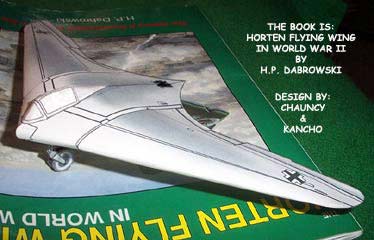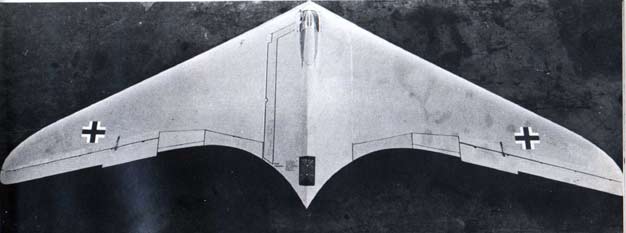


Horten IX glider - $$5.95
The first Ho IX V1, which was an unpowered glider that first flew on 1 March 1944. It was followed in December 1944 by the Jumo 004-powered version 2. Göring believed in the design and ordered a production series of 40 aircraft at Gotha with the RLM designation Ho 229. (see above) The war's end altered his plan somewhat.
Horten H-IX Flying Wing Glider
 Like most Nazi aircraft built toward the end of the war, it was primarily made of plywood with a welded tubular steel frame.
Like most Nazi aircraft built toward the end of the war, it was primarily made of plywood with a welded tubular steel frame.
The retractable nose wheel was actually the TAIL wheel taken from a scrapped bomber.. The main landing gear was 'fixed' to create the aero dynamical drag of the missing engines. During WWII the Germans were busy developing new and better aircraft. Powered with the new jet engine the flying wing was a perfect configuration.
Horten Ho-IX WWII Flying Wing Glider

Check out these other Horten Flying Wing models from Fiddlersgreen
Ho-IV / Ho-229
Walter Horten was aware of the performance
achieved by the DFS 194 rocket-powered research aircraft, and
thus knew that wooden construction methods were suitable for high-performance
aircraft. After seeing the Me 262 in March 1943 he set out to
acquire information on the Jurno 004 turbojet engine. Further
work on the H VII was abandoned and all efforts were concentrated
on the H IX, which originated from Goring's 1000 x l000 x 1000 demand,
in which the Reichsmarschall specified that no new project would
be considered unless it achieved the following performance figures:
a speed of at least 1,000 kph and the ability to carry a 1,000
kg bomb load 1,000 kin into enemy territory justifiable deviations
from these figures would be accepted. 
At that time Walter Horten was a Hauptmann on the staff of Lln3. He managed to obtain a transfer to Gottingen, where he took over command of Luftwaffenkommando IX. Soon afterward, however, the Kommando was officially disbanded, and as a result Lln3 ceased to be the office responsible for development of the Horten projects. New life was injected into the Horten Firm, when, in August, Hermann Goring informed the company that work on the H IX turbojet fighter-bomber was to proceed with all urgency and that it was to construct a flyable, but un powered, example as soon as possible.
Luftwaffenkommando IX, which officially no longer existed, continued to be funded and carried .on its work, but without direct influence from the Technischen Amt of the RLM. The H IX VI was an un powered research glider and received the RLM-Number 8-229.
 The aircraft was of mixed construction (welded
steel tube and wood) and was covered with several layers of plywood
of various qualities, the outer layer being of the best quality.
This method of construction made radar detection of the aircraft
extremely difficult. The pilot was accommodated in a normal seated
position. The first flight of the V1 took place on March 1, 1944,
at Gottingen with Heinz Scheidhauer at the controls. Following
several towed takeoffs, the aircraft was sent to Oranienburg near
Berlin for flight testing, with Scheidhauer as pilot. A brief
report submitted by the DVL on April 7, 1944, indicated that the
aircraft provided an excellent gun platform.
The aircraft was of mixed construction (welded
steel tube and wood) and was covered with several layers of plywood
of various qualities, the outer layer being of the best quality.
This method of construction made radar detection of the aircraft
extremely difficult. The pilot was accommodated in a normal seated
position. The first flight of the V1 took place on March 1, 1944,
at Gottingen with Heinz Scheidhauer at the controls. Following
several towed takeoffs, the aircraft was sent to Oranienburg near
Berlin for flight testing, with Scheidhauer as pilot. A brief
report submitted by the DVL on April 7, 1944, indicated that the
aircraft provided an excellent gun platform.
In order to simulate the stabilizing effect of the engines, which were absent from the VI, the aircraft's main undercarriage legs were faired from the outset; only the aircraft's nose wheel was retractable. On March 5 the nose gear failed after it developed a wobble on Oranienburg's concrete runway. A special pressure suit was to have replaced the absent cockpit pressurization, but was never used in practice.
The machine was sent to Brandis, where it was to be tested by the military and used purposes. It was found there by soldiers of the 9th Armored Division at the end of the war was unfortunately burned in a 'clearing action.'



 |
 |
 Computer images by Kancho |
Fun Facts about the Horten Brothers ..... During World War II, brothers Walter and Reimar Horten designed a prototype for a German stealth plane that, if completed, could have changed history as we know it. |
See also Horten Ho-IV and Horten Ho-229



